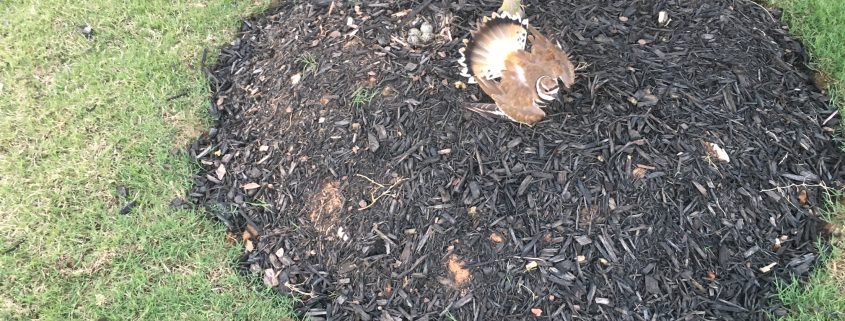Four New Killdeer Residents — Deep Lessons from our Partnership with Nature
May 20, 2017, we noticed a six-inch diameter dimple in the round elevated bed (where we had planted one of our backyard specimen trees — a Japanese maple — earlier in the spring) 15 feet from the patio. We wondered what bird had taken the time to make its mark… and why? The next day as I walked past to retrieve the shovel leaning nearby against the house, a killdeer sounded alarm, lurching away in full broken-wing anguish. Ah, I knew that trick of distraction. There in the dimple sat a single, spotted tawny egg. Mystery solved. Over the next few days, the female deposited three more. We watched the nest, mom and dad, and the eggs, soothing the frantic parents (well, we said words intended to soothe; the birds simply chirped, screamed, and did the broken-wing thing) whenever landscape duties took us close.
We left for Pittsburgh to visit our son and his family June 15, knowing that the incubation period was nearing an end. Sure enough, our neighbor texted June 19, to announce that four killdeer hatchlings emerged that day, and almost immediately, as killdeer young do, wandered off with their parents before Deborah could grab her camera. We returned home June 21, and have seen hide nor hair (feathers, I suppose) of the brood. Still, we celebrated the successful hatch.
June 22, I exited the patio door early morning, and witnessed a sparrow hustle away from the large flower pot at the bed-edge adjacent to the stoop, moving in a manner clearly intended to draw my attention. No flying for this bird. After a couple repeat retreats by our friend, I ventured a look into the petunias and coleus, where I found a tiny nest and three bluish eggs. [Note that I referred to the bird as a sparrow. Sorry, that’s the best i.d. I can offer. If I attempted to narrow to species, I would do so with very little confidence.] Once again, the recent landscaping around our new home, built in a rather sterile former agriculture field, planted to houses within the past three years, is providing essential habitat to avian wildlife.
The willows (native, naturally seeded, and now growing profusely) at our shore are home to two red-wing blackbird nests. The males are such territorial aggressors. Pity any bird wondering near. The duck family (the ten ducklings) no longer swims, forages, and comports as a tight regiment. The youngsters, as large as momma, have begun to venture forth on their own or in groups of two and three. They are flying! We seldom see our family of four goslings, or perhaps the young are big enough that we don’t spot them as such.
My point in all this — we humans are one with nature. We clear the woods, plant crops for a few decades, scrape out a four-acre pond, and then parcel the land to one-third acre lots, grow a few houses, put in a bit of grass, flowers, and shrubs, and look out — birds, turtles, frogs, toads, snakes, and other critters move in with us. Such a joyous explosion of life. I wonder, though, how many of our human neighbors notice… and rejoice? Do others appreciate the richness and bounty the way we do? How many actually LOOK, and of them, what subset can really SEE? Even fewer, I suppose, can FEEL and sense the power of this natural world we share. And how many feel deeply enough to ACT on behalf of assuring that nature’s beauty, magic, wonder, and awe extend through our generation and beyond. How many can articulate and practice an Earth ethic… the basic tenets of Earth stewardship?
Great Blue Heron, LLC helps people look, see, feel, and act in a manner reflective of our place in the world. Our little paradise on Big Blue Lake reminds me that every lesson for living, learning, serving, and leading is either written indelibly in or is compellingly inspired by nature. My advice: occasionally (even frequently) forget the hand-held device; escape the absolute tyranny of the urgent; open your eyes; breathe the magic of the world around you. Whether a nearby natural area, a formal wilderness, or a landscaped suburban lot, the magic is within reach. Choose to embrace it!
Featured Photo: Look closely behind the terribly disturbed/annoyed killdeer doing the broken-wing act — see her four eggs!



